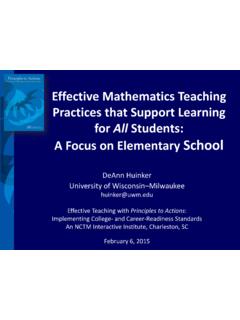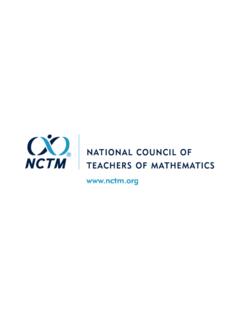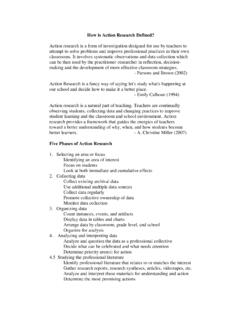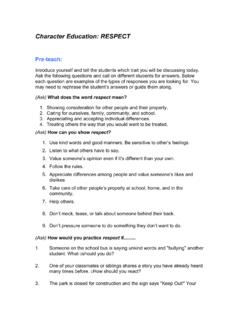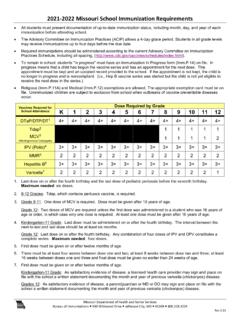Transcription of Base Ten and Place Value - National Council of Teachers of ...
1 Base Ten and Place Value NCTM Interactive Institute, 2015. Courtney Baker Jennifer Ward George Mason University University of South Florida Workshop Goals Participants will --- Represent and solve a problem (Activity 1). requiring an understanding of counting and Place Value (Essential Understandings 1, 2, and 3). 2. Goal 1. Participants will . Discuss and reflect on pedagogy necessary to teach counting, comparing, and representing numbers (Essential Understandings ONE and TWO): Identify counting and sequencing criteria (Activity 2). Match counting and comparing standards to activities appropriate in Prek 2nd grade (Activity 3). Use number counting and comparing vocabulary to solve a color tile clue problem (Activity 4).
2 3. Goal 2. Participants will . Discuss and reflect on pedagogy necessary to teach Place Value concepts. (Essential Understandings ONE and THREE): Play two different Place Value games or activities. Identify the Place Value concepts that could be addressed (Activity 5 ). Use a variety of strategies to assess students' concepts of Place Value (Activity 6). 4. Base 10 & Place Value An understanding of number involves integrating several key concepts, such as unit, Place Value , and one-to-one correspondence . Ideas such as unit and decomposition that children encounter in prekindergarten through grade 2 set the stage for their development of fluent use of Place Value , leading to number flexibility and computational proficiency.
3 (Dougherty, Flores, Louis, Sophian, 2010, p. 41). 5. Characteristics of the Numeration System (Adapted from Reys, Lindquist, Lambdin, Smith, & Suydam, 2004). Place Value : The position of the digit represents its Value : for example, the 2 in 23 names twenty and has a different mathematical meaning from the 2 in 32 which names two.. Base of ten: The term base simply means a collection. Thus in our system, 10 is the Value that determines a new collection, and the system has 10 digits, 0 through 9. Use of zero: A symbol for zero exists and allows us to represent symbolically the absence of something. For example, 309 shows the absence of tens in a number containing hundreds and ones. Additive property: Numbers can be summed with respect to Place Value .
4 For example, 123 names the number that is the sum of 100 + 20 + 3. 6. Place Value Development Counting by Ones Physical item worth a count of one more . Each item is a unit of one. Items being counted compose the total. Number word stand for its numerical Value to represent the entire quantity. Example: One, Two, Three, Four Four blocks Counting by Groups and Singles A collection of items can be thought of as a group. Groups can contain different quantity of items. Example: One, two, three groups of two, and one, two, three, singles 7. Place Value Development Counting by Tens and Ones Ten is used as a unit. Count by tens and ones: 10, 20, 30, 40, 41, 42, 43. Tens and Ones are dealt with separately. Example: When I add 15 blocks with 17 blocks, I have two tens and 12.
5 Ones Equivalent Groupings Ten is used as a unit. Tens and ones are dealt with simultaneously Mental flexibility permits crossing between thinking of tens and ones Example: Three tens and 13 ones is also equal to 43. 8. It is critical that students see the relationship between number names such as fifty-three with the grouping of tens concept. They must also see that the way we write numbers (ones on the right, tens on the left of ones and so on) must be coordinated with the idea of groupings. Van de Walle, John A., and LouAnn Lovin. 2006. Teaching Student-Centered Mathematics: Grades K-3. Boston: Pearson Education. 9. Activity 1. Positional System and Representations of Place Value Models for Place Value Physical models can help children develop the idea of a ten as both a single entity and a set of ten units.
6 The models do not show the concept to the children. Children must construct the concept, and impose it on the model. Quick Write Identify the tools that students in your classroom use during study of Place Value Groupable and Pre-grouped Groupable models most Pre-grouped models are clearly reflect the trading/exchanging relationship of ones and models. tens Pre-grouped models are The ten can actually be introduced when children made by grouping the need to represent singles. When children hundreds. stack 10 cubes the tower Children cannot actually of ten is literally the same take them apart or put as the ten ones from which them together. it was made. When 10 single pieces are These can be called put- accumulated they must be together/ take-apart exchanged, regrouped or models.
7 Traded, for a ten, ten tens must also be traded for a hundred. Students should have exposure to groupable models first to see the one to one relationship Groupable Pre-grouped Proportional and Non- Proportional Proportional models Non-proportional help to demonstrate an models lack an exact exact size ratio between ratio between the values. quantity presented and The material for 10 is size of tool used. ten times the size of 1; Within money, ten 100 is ten times the size pennies are not the of 10. same size as one dime. Proportional The material for 10 is ten times the size of 1; 100 is ten times the size of 10. Tens Ones Ex: base ten blocks, bean sticks, bundled sticks Nonproportional The material does not maintain any size relationships.
8 Ex: money, abacus, color tiles or chips Base 10 Models Base 10 models are considered both groupable and proportional These models support students in experiencing the relationship between places by Building quantities Regrouping to see the relative magnitude of places Supporting regrouping during addition and subtraction operations Straws, Bundles and Bags Frequently items such as straws or popsicle sticks are used to model Place Value concepts These models are considered groupable and proportional It is important for students to engage in the task of putting together and taking these models apart to explore the relationship between places. Can you model . With the materials at your table, create representations of the following numbers.
9 Try to use at least two different materials (1. groupable, 1 pre-grouped). 17. 45. 89. 123. 19. Activity 2. Composing, Decomposing, &. Renaming Numbers Representing Numbers In order to develop children's understanding of number, it is important that we ensure they have multiple opportunities to experience and express numbers in a variety of ways. The Place Value Triangle: Experiences in saying, writing and building numbers Renaming Numbers: Experiences in representing the same Value in multiple ways 21. Place Value Triangle: Connecting Concepts with Oral and Written Forms Base-Ten Concepts Standard and equivalent groupings meaningfully used to represent quantities Counting By ones By groups and singles By tens and ones Oral Names Written Names Standard: 32.
10 Thirty-two Base-Ten: Three tens and two 22. Make It! Build It! Say It! 1. Make It! Draw 2 cards and Place them on the sentence strip. 1. Build It! Use the Base 10. blocks to represent your number 1. Say It! Read your number. Extension: Include question cards that ask about: Digit Value Place Make It! Build It! Say It! Compare It! >. 1. Play with a partner! 2. Each player will Make It! Build It! Say It! 3. Then one student will Compare It! This student will Place a symbol between the numbers to make a true expression! Renaming/Decomposing Numbers We would like children to develop the idea that there are many equivalent (equal) names for one number. Because arithmetic, for the most part, involves replacing numbers or expressions with equivalent numbers or expressions (we replace 5 + 7 with 12 or.)
